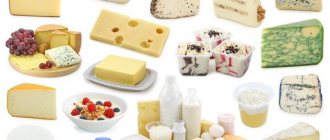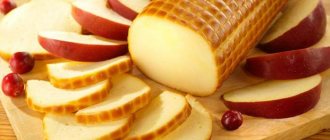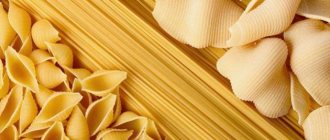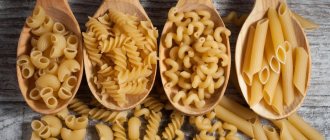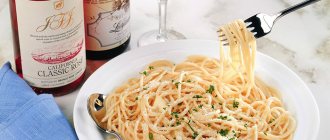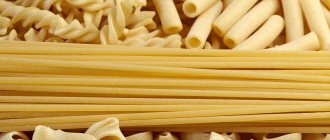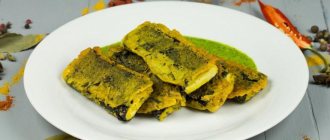In the usual understanding, any diet is inextricably linked with the need to give up many foods, which include pasta. This dish, which came to us from Italy, has become an integral part of the diet of most people, so giving it up even during a diet is not an easy task.
Those who have decided to get their figure in order, get rid of excess weight and find the strength to live, do not necessarily have to limit themselves to such a product as pasta. However, in this matter, strict adherence to measures and the selection of high-quality samples made exclusively from durum wheat are necessary.
Product Description
What is pasta? These are products made in various forms, in most cases from wheat flour. The dough is kneaded using purified drinking water and then dried using special technologies. In some cases, manufacturers use rice or buckwheat flour. Many of us have seen colorful pasta on supermarket shelves. To obtain such a product, tomato paste, spinach or eggs are often added. The properties of such products directly depend on the type and quality of the ingredients used.
How many grams of carbohydrates are in 100 grams of pasta? It all depends on their variety, composition and preparation method. In this article we will return to this issue, but a little later.
In accordance with established GOST standards, products are divided into several categories:
- group A - pasta made from durum wheat flour of the first and second grades;
- group B - pasta from soft glassy wheat of the highest and first grades;
- group B - pasta products made from premium and first grade wheat baking flour.
Durum pasta contains slightly more gluten and less starch. But soft varieties include significantly more starch and less gluten. Proper and high-quality pasta contains virtually no fat or its amount is quite low.
Another type of this product is whole grain pasta, which is made from whole grains. The composition is striking in its high content of nutrients and minerals with such a low calorie content. However, before moving on to the carbohydrate content of pasta, we will look at its beneficial properties.
Decoding information on packages
When losing weight, you should not buy pasta that contains the following components:
- Synthetic flavors.
- Salt.
- Traces of dairy products such as milk or whey.
- Eggs.
- Artificial colors and preservatives.
Additives such as paprika powder, natural tomato or spinach do not pose a threat to health and can be used in the diet. The packaging must contain the inscription “durum”, “durum wheat”, “group A” or “1st class”. Unlike pasta made from soft varieties, durum spaghetti bends perfectly and is quite durable. In order to break them, you need to make some effort.
Benefits and harms of products
The main positive qualities of pasta include the following factors:
- fiber, which is part of the product, is easily absorbed by our body, gives strength and retains protein;
- the fat in pasta is unsaturated, so it breaks down easily and makes our skin firmer, healthier and more elastic;
- quick saturation of the body;
- pasta is good for digestion and the cardiovascular system, thanks to its fiber;
- the same fiber allows you to easily and quickly remove all waste and toxins from the human body;
- contains B vitamins, phosphorus, calcium, potassium, iron and so on.
So how many carbs are in cooked pasta? It all depends on the variety, but the average value ranges from 40 to 60 grams.
Do not forget that excessive consumption of pasta can lead to excess weight gain. In this case, it is best to use whole grain pasta. This is due to the high content of nutrients and minerals, low calorie content and a brighter taste. But the price for such products will be much higher.
How to lose weight on spaghetti?
Having briefly examined the calorie content and benefits of spaghetti, let's move on to the process of losing weight when eating spaghetti. We will eat spaghetti 3 times a day, 100 grams each. dry product. Correctly measure exactly 100 grams. For spaghetti, we can use a spaghetti dispenser or a regular kitchen scale. When cooked, spaghetti will gain volume due to water, but the calorie content will not change. (Be sure to read how to cook spaghetti so that its glycemic index does not increase). For taste you can add: vegetable oil - the required amount (if there are no animal fats in the diet, then the calorie content of vegetable oil can be ignored, it will not be absorbed by the body), butter - a very small amount (it is better to replace it with vegetable oil), ketchup, sauce , adjika - to taste (add as much as you want, but only so that the total amount of carbohydrates per meal does not exceed 90 grams. Remember that almost 72 grams of carbohydrates will give 100 grams of spaghetti). To satisfy hunger and better taste, you can include tomatoes, cucumbers and any other low-calorie product in your meals, but again you need to make sure that the total amount of carbohydrates does not exceed 90 grams. Otherwise, everything that exceeds this line will be processed by the liver into fats. After meals, you can recommend hot tea without sugar or another drink. It is only important that the drink does not include carbohydrates so that it does not exceed the 90 g line. carbohydrates. And so on three times a day. Your diet will not be varied, but fresh, low-calorie vegetables will provide your body with the vitamins and minerals it needs. Spaghetti will give you energy and satiety. Drinking tea at the end of a meal will further increase your stomach for a while, so that the receptors send a signal to the brain about satiety. You will get a minimum of calories, the maximum your body needs with such a meager diet and, most importantly, you will not experience hunger. How much weight can you lose by eating spaghetti? Let's say you decide to follow this diet for a month. Let us remind you that the body will receive the carbohydrates it needs, a certain amount of protein, vitamins, and minerals (if you eat at least 1 cucumber, tomato, etc. per meal). We count: 1 meal: 100 gr. spaghetti, 100 gr. cucumbers (1 fairly large cucumber), 1 tomato (150 gr.), 70 gr. spaghetti sauce (for example, Dolmio), vegetable oil, tea without sugar. This gives per meal: protein - about 13 g, fat - about 1.8 g, carbohydrates - 85 g. (let it be 90 g - the maximum norm). Vegetable oil can not be counted, because... We don't have animal fats here. Total total calorie content: about 440 Kcal (in general, a little too much). Eating this way 3 times a day (and you can drink tea at any time, in between), it turns out that we will get 1320 Kcal per day. And the norm is 2500 Kcal. This means that our body will have to consume 1180 kilocalories from its own fat reserves. As a result, in 1 day we will lose 126 grams. own fat and another 42 grams. due to muscle fibers. In total, the body will lose 168 grams of weight in just 1 day (sometimes a little more, due to lost water). Total weight loss over a month (30 days) will be: 3.78 kg of fat and 1.26 kg of muscle fiber. Together - 5.04 kg of own weight, most of which is fat.
We will not starve, we will not exhaust the body with physical activity, we will eat our favorite spaghetti, but we will certainly lose more than 5 kg of weight. Those who don’t believe can verify this for themselves in just a month. Just carefully read all the conditions for such a result.
Liked? Share!
Interesting Facts
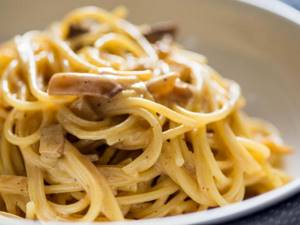
Before we get into how many carbohydrates are in pasta, we suggest you consider some interesting facts about this product.
So, a few facts about this product:
- 100 grams of raw pasta turns into a 250 gram serving;
- It’s best to stick to pasta made from durum wheat;
- the glycemic index of this product is 50. But if they are slightly undercooked, the index is reduced to 40;
- ideal pasta has a golden hue with an admixture of amber color;
- the structure of a quality product is quite dense, but at the same time flexible;
- When cooking good pasta, the water does not change its color, and the product itself does not boil, deform or stick together.
Italian film actress Sophia Loren, known for her slim figure and beauty, tells the public that she loves and constantly cooks pasta with various fillings. “I owe everything I have to spaghetti,” says the public figure.
How to choose?
The packaging itself must contain information that the pasta is made from durum wheat or “durum”.
The surface of the pasta should have dark spots, which are residues directly from the grain shells.
Pasta from soft varieties has similar white dots. Quality products should be golden or amber in color. If there are fragments of pasta or crumbs inside the package, this clearly indicates low quality of the product.
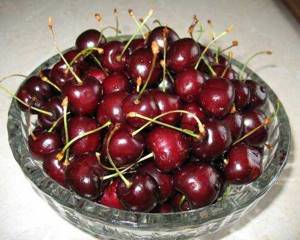
Finished products should not stick together, form lumps, overcook and remain elastic. After cooking, the serving size approximately doubles. The water left over from cooking pasta should be relatively clear and not cloudy in any way.
Otherwise, it can be argued that these products contain harmful starch, characteristic of soft varieties of wheat.
How many grams of carbohydrates are in pasta?
Now that we have learned about the beneficial properties and categories of the product, we can move on to its nutritional value.
Dry pasta contains:
- proteins - 10.4 grams;
- fats - 1.1 grams;
- carbohydrates - 64.5 grams;
- calories - 327 kcal.
How many carbohydrates are in boiled durum pasta:
- proteins - 3.5 grams;
- fats - 0.4 grams;
- carbohydrates - 23.2 grams;
- calories - 112.
However, do not forget that if you add butter or various sauces to pasta, the calorie content increases to 170 kcal. But everyone’s favorite dish, navy-style pasta, has about 230 kcal. Therefore, they should not be abused by those losing weight.
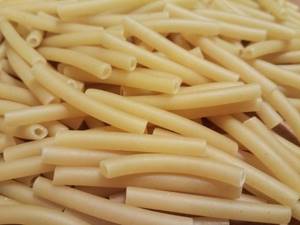
Now you know how many carbohydrates are in solid pasta, what their energy value and benefits are. Knowing this data, you can easily adjust your own diet. Many people mistakenly believe that after eating a portion of pasta, they will immediately gain excess weight. But this is not so, because products made from durum wheat allow you to eat your favorite spaghetti or noodles, while remaining slim and healthy.
Premium quality boiled pasta
For a very long time, pasta has been used as one of the types of side dishes for any dish (meat, fish, vegetables).
This product has never been in short supply, which is most likely why people are accustomed to using it quite often.
This is logical: affordable, nutritious and varied products are always at hand, they do not require any high level of cooking and can always be supplemented with something.
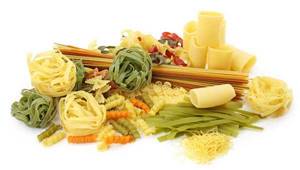
But due to the increased interest of society in healthy and so-called proper nutrition, the demand for ordinary products has dropped slightly, everyone is now actively looking for pasta that will bring benefits. Let's figure out how to choose pasta wisely
Types of pasta
Pasta is a dough product, usually made from wheat flour with the addition of water. These are also slow carbohydrates that give you a feeling of fullness for several hours. But nutritionists and nutrition experts recommend consuming durum wheat pasta, as it contains more beneficial micro- and macroelements.
To date, the variety of products is very large, so it is worth being able to distinguish between them. They differ in shape, color, taste and cooking speed.
Long products (also called pasta):
- vermicelli;
- spaghetti;
- spaghettini;
- fettuccine;
- capellini, etc.
Short products:
- tortiglioni;
- maccheroni;
- cavatappi, etc.
Figured products:
- farfalle (we call them “butterflies”);
- conchiglie (or “shells”);
- capeletti (similar to small Russian dumplings), etc.
All names of pasta are Italian, since, according to experts, it was in Italy that they became widespread. After all, over 200 pasta dishes are known there!
Our body benefits from consuming this product. And the most important ingredient in them is fiber, which helps the gastrointestinal tract function properly and cleanses the body of all kinds of toxins and undigested elements. Pasta is a high carbohydrate product.
Many (especially women) try to completely exclude them from their diet. But in vain, since these are slow carbohydrates that take longer to digest and do not affect blood sugar levels in any way. Moreover, athletes, people with high levels of physical activity, and even those on a diet are strongly recommended to use this type of product.
After cooking, the pasta does not lose its beneficial substances, macro- and microelements.
A little trick: when cooking pasta, try to undercook it a little. The result will be so-called “al dente”, as the Italians say. The benefits from them are greater and the feeling of fullness lasts longer.
Calorie content
Calorie content in its pure form (i.e., those products that have not been subjected to heat treatment) varies from 300 to 400 kcal per 100 grams. You can find the composition and KBJU (calories, proteins, fats, carbohydrates) on the product packaging itself.
When cooking, the calorie content does not change, but remember that calories are counted by the dry weight of the product, and not by the finished weight. That is, first you need to weigh a certain amount of pasta that you want to cook and “drive” it into your calorie counter. It is then that the figure will be correct, because when cooked, pasta tends to boil over and becomes heavier, which accordingly changes its weight.
The calorie content of pasta depends on its type and manufacturer. For example, buckwheat pasta will have about 370 kcal per 100 g, but regular, whole grain pasta can have either 333 kcal/100 g (Naturata pasta) or 360 kcal/100 g (JamieOliver).
The calorie content of a dish directly depends on the ingredients you use for cooking. To more or less accurately determine the energy value of your dish, it is best to count all the ingredients separately.
How to choose the right pasta among such a huge amount presented on the shelves?
- Of course, the surest way to choose a good product is to look at the composition and KBJU on the product packaging. Please note that “proper” pasta should contain at least 10 grams of protein per 100 grams.
- Don't forget that a good product will not be sold by weight!
- The color of the product should not be bright or too conspicuous, otherwise it will be clear that dyes have been added to it.
- If you notice white specks on the pasta itself, then you should not take them, this is a sure sign of low-quality flour.
- A pronounced smell (musty, for example) indicates improper storage of the product or the end of its shelf life.
- The pasta packaging must be sealed and transparent so that the contents can be clearly seen.
- After cooking, a lot literally “floats” to the surface: the water should be clear, not cloudy, and no white foam should accumulate on the surface.
- The price for good pasta is, accordingly, higher than for a not very high-quality product.
- And you should already choose the shape of the pasta at your discretion.
The calorie content of cooked pasta changes during cooking. This is influenced by the amount of water and what additives you use to add flavor and aroma to the dish. But there are also other nuances - be sure to look at the calorie content of the paste on its packaging, because depending on the brand and composition, the energy value can vary significantly.
Often, without thinking, we put something into ready-made pasta for taste and smell, for example, salt, soy sauce, seasonings, sauces, sour cream, butter, etc., without thinking about how much they increase the calorie content of the entire dish.
For many this is not a problem, but there are those who watch their diet very strictly or adhere to a certain diet. That is why you should carefully monitor what and in what quantity you add to the prepared product.
This is especially true for additives such as cheese or meat, because they are quite fatty and high in calories.
Below are several dishes whose main ingredient is pasta. These dishes are easy to prepare, low in calories, but will bring great benefits to your body!
Ingredients:
- chicken fillet – 800 g;
- olive oil – 1 tbsp. spoon;
- broccoli florets – 2 cups;
- finely chopped onion - half a glass;
- salt, spices - to taste.
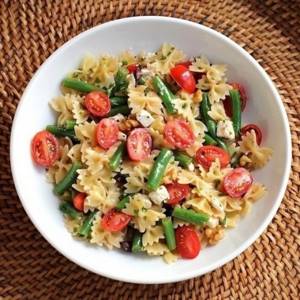
Heat a frying pan over medium heat, add olive oil. Cut the chicken fillet into small cubes and fry in a frying pan until golden brown. Add onion and pre-boiled broccoli to the fillet. Add a little water and simmer everything until the onion acquires a darker (golden) color.
While the vegetables and chicken are stewing, pour water into a saucepan, bring to a boil, add the pasta and cook until tender (8-10 minutes). After which you can lay out the pasta and add chicken and vegetables there. Use salt and seasoning to taste.
Ingredients:
- pasta – 1 package (400-500 g);
- grated hard cheese – 100-150 g;
- cream 10% - 100 ml;
- salt and spices to taste.
Following package instructions, cook pasta until done. Heat the cream in a small, shallow saucepan and add the grated cheese. Season with spices. Stir slowly and remove pan from heat when cheese begins to melt.
Drain the pasta in a colander, transfer it to a plate, and top with cheese and cream sauce. The dish can be decorated with finely chopped herbs.
Ingredients:
- fettuccine (thick noodles) – 400-500 g (1 pack);
- olive oil – 2-3 tbsp. spoons;
- sea cocktail – 100-150 g;
- tomatoes – 5-6 small pieces;
- onion – half a whole or 1 small;
- greens (dill, parsley);
- salt;
- spices.
Place a saucepan of salted water over low heat, add the fettuccine and cook until tender, following the instructions on the package.
Add olive oil to a hot frying pan, finely chop the onion and fry until golden brown. Then finely chop the tomatoes, simmer them a little with onions and add the sea cocktail. Stirring constantly, simmer for 3-5 minutes. Place a mixture of tomatoes and seafood on the finished pasta, sprinkle with herbs and seasonings on top.
Ingredients:
- green beans –250-300 gr;
- tomatoes – 2 pcs.;
- garlic – 2 cloves
- olive oil – 2 tbsp. spoons;
- tomato paste – 2 tbsp. spoons;
- salt;
- ground black/red pepper.
In a saucepan of salted water, cook the pasta until tender, following the instructions on the package. Peel the tomatoes, cut into squares along with the garlic and simmer with olive oil over low heat for 3 minutes.
Add frozen beans to tomatoes and simmer until tender. At the end, add tomato paste and seasonings and mix. Place the pasta on a plate, add beans and tomatoes on top. You can season it with soy sauce.
Pasta with tuna
Ingredients:
- pasta – 400-500 g (1 package);
- tuna in its own juice or in vegetable oil – 100 g;
- butter – as needed (if tuna is in oil, you shouldn’t add more);
- tomato paste – 2-3 tbsp. spoons;
- ground pepper mixture;
- salt.
Boil water in a saucepan, add a little salt and add the pasta. Finely chop the tuna, add oil and tomato paste to it. Let it cook for a few minutes. When the pasta is ready, place in a colander, place on a plate, and top with tuna and tomato sauce. Salt/pepper.
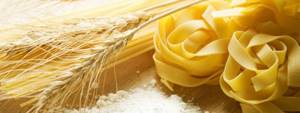
So, we looked at the topic of energy value, benefits and consumption of boiled pasta. I hope we've debunked some of the most common myths about pasta. Now you know that pasta is not only an affordable, but also a healthy product, from which you can make a huge number of delicious and dietary recipes!
Pasta made from premium wheat flour has the lightest, almost white color, floury smell, and breaks easily. You should cook premium pasta for no more than 7-10 minutes, depending on the shape of the product, so as not to boil it, but to leave a slightly hard core of the pasta.
The calorie content of premium boiled pasta is 112 kcal per 100 grams of product.
There is no need to talk seriously about the beneficial properties of pasta; the advantages of this product are its availability and speed of preparation.
You need to understand that pasta contains so-called “fast” carbohydrates, which quickly saturate, glucose instantly enters the blood, but the effect does not last long, after a while the brain again requires the supply of nutrients (calorizator).
- Macaroni (pasta) is very tasty and healthy if prepared and served correctly. They are best served with pasta (I would say this is a classic), you can serve them with olive oil, with cheese, with vegetables, it will be very tasty with tuna. In addition, even if the pasta is of the highest quality, but from a different manufacturer, it has different calorie content. This is important to take into account for those people who eat a healthy diet and count the calories they eat. By the way, the amount of protein in pasta depends on the manufacturer, technology and, of course, the cooking recipe itself. The leading positions in many summary calorie tables (read on the Internet) are given to Italian pasta. The amount of protein in them ranges from 12 to 14 grams per hundred grams of product. This is very good and suggests that this pasta is not only incredibly nutritious, but also very tasty.
Cooking the Italian way
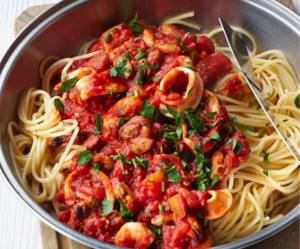
Having figured out how many carbohydrates are in 100 grams. pasta, we can move on to the simplest and most delicious recipe.
So, the necessary products:
- tomatoes - 4 pcs;
- garlic cloves - 2 pcs;
- pasta - 200 grams;
- green peas - 200 grams;
- olives - 5 pcs;
- hard cheese - 50 grams;
- chicken egg - 1 pc;
- vegetable oil - 1 tbsp;
- basil - half a bunch;
- salt;
- ground black pepper.
If desired, tomatoes can be replaced with thick tomato paste.
How much milk in pasta? How much porridge for solid gatunka pasta?
- Pasta (pasta) is very tasty and nutty, so it is easy to ripple and fall. Lepsh for everything, you can eat it with pasta (I would say it’s a classic), you can eat it with almond alley, with cheeses, with garlic, with tuna Velma Smachna Budze. Akramya tago, navat kali macaroni vysheishaga gatunku, ale hell roznaga vytvortsy, yany majuts roznuyu kalarynasts. Gata is important for people who eat the right food and treat consumed calories. Darechs, hell creators, technology and, of course, the very recipe of the dough, deposits and kolkast porridge in pasta. Lidzіruyuschie pages on many summary tables of the Kalariynasts (read on the Internet) added value to Italian pasta. They have a total of 12 and 14 grams per hundred grams of product. This is great goodness and it’s true that Dadzen’s pasta is not only incredibly tasty, but also delicious.
- Different creators par-znamu atsenvayutsya instead of getaga samaga bialku... greedy for other people's merits... greedy with creative pranksters... inventive misunderstood things... but as a whole, everything ends in treatment - 10-12%
Russian producers often add and bake hard gatunka pasta with washed-up porridge in the area of 10.4 – 10.7 grams per hundred grams of product.
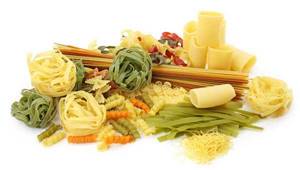
Step by step process
Our actions are:
- Pour cold water into a small saucepan, place on medium heat and wait until it boils.
- Open the package of pasta and pour it into salted water.
- Cook according to the instructions on the package and drain in a colander.
- Pour boiling water over the tomatoes, carefully remove the skin and cut into small cubes.
- Blanch the green peas in salted water for about three minutes and pour into a colander.
- Wash the basil greens and chop them with a sharp knife.
- Peel the garlic cloves from the film and divide into small pieces.
- Grate the cheese on a medium grater.
- Grease a baking dish with vegetable oil and place pasta in it.
- Add tomatoes and peas, mix the resulting mass thoroughly.
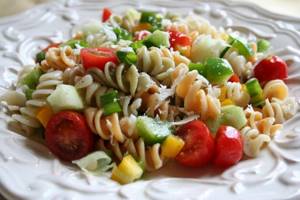
- In a separate bowl, beat the chicken egg with spices and salt.
- Pour the egg mixture over the pasta, add grated cheese and place the mold in the oven for 15 minutes.
Before serving the finished dish, it must be garnished with chopped herbs and garlic. How many carbohydrates are in pasta? Approximately 62-65 in this dish per 100 grams.
Cooking method
What needs to be done:
- Following the instructions on the package, boil the pasta until tender and drain in a colander.
- Pour the required amount of cream into a saucepan and slightly heat the resulting mass.
- Grate the cheese and mix with cream.
- Add spices, salt and, if desired, some fresh herbs.
- Simmer over medium heat until the cheese begins to melt.
- Transfer the pasta to plates, pour in the sauce and serve.
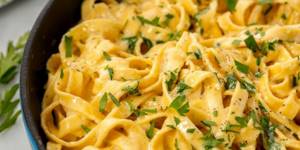
You can bake fish or chicken thighs with this dish.
Step-by-step preparation
Our next steps:
- Place a saucepan of cold water over medium heat and bring the liquid to a boil.
- Pour the pasta into boiling water, add a little salt and cook according to the instructions on the package.
- As soon as the pasta is ready, place it in a colander and allow time for excess liquid to drain.
- Pour hot water over the tomatoes, peel them and cut them into cubes about 1 cm thick.
- We pass the garlic cloves through a special press.
- Heat olive oil in a frying pan, add tomatoes and garlic.
- Simmer the resulting mixture for about three minutes.
- Now pour the green beans into the frying pan, cook for five minutes and pour in the tomato paste.
- Sprinkle all the ingredients with spices, mix and remove the pan from the heat.
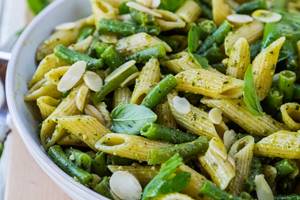
Transfer the pasta to plates and add green beans, tomatoes and garlic on top. For a brighter taste, you can add soy sauce. The amount of carbohydrates in pasta is about 60-40 grams.


